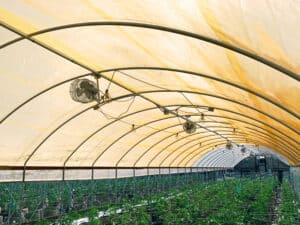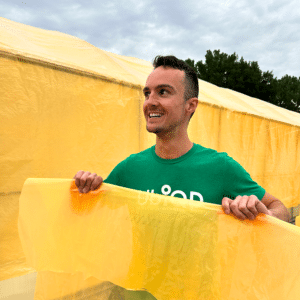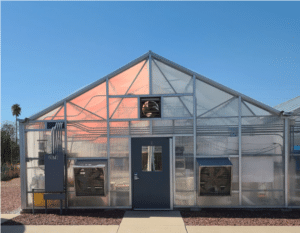
UbiGro Greenhouse Cover FAQs
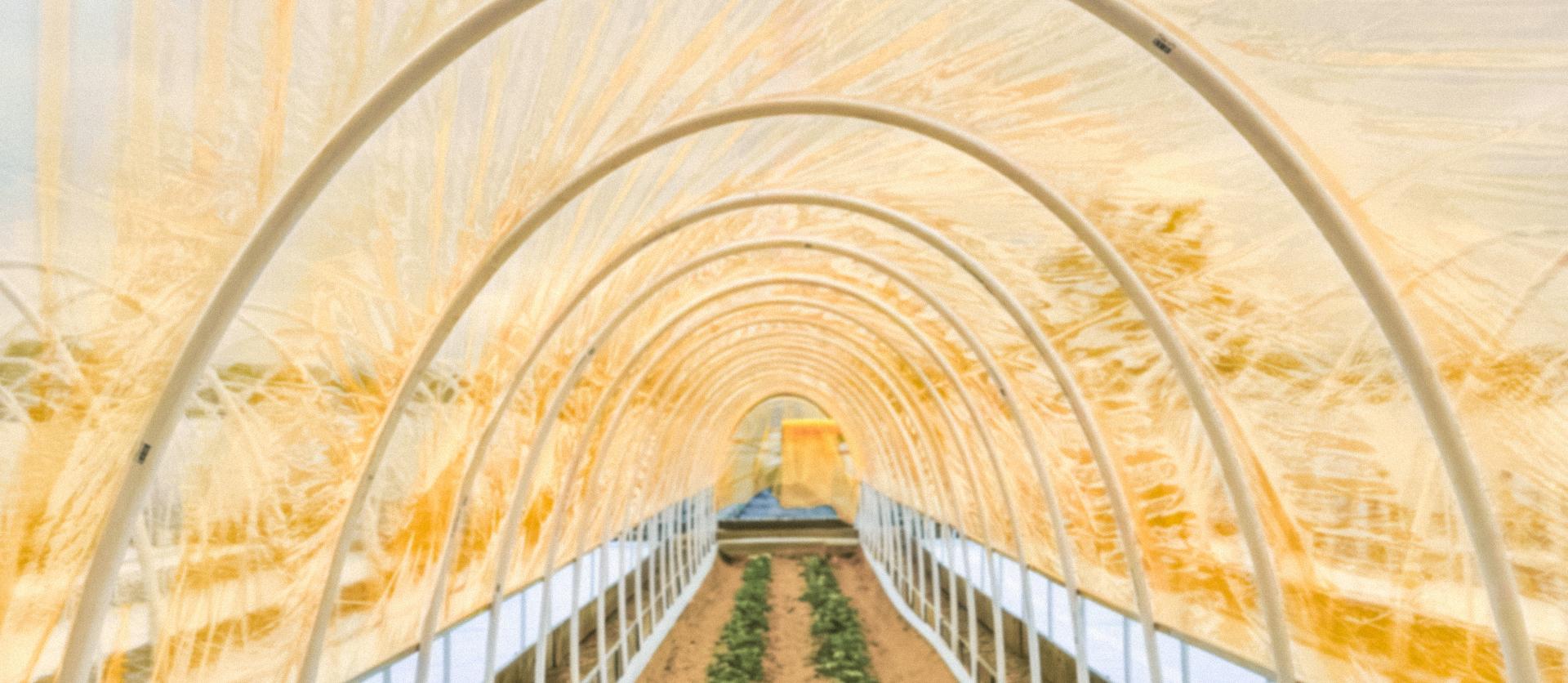
Discover the science behind the orange glow of UbiGro Cover and its role in enhancing photosynthesis. Learn about optimal usage in double-wall poly greenhouses and why UbiGro is a safe choice with its exclusive non-toxic Quantum Dots. UbiGro’s greenhouse covering material is at the forefront of agriculture technology, using red-shifting quantum dots to optimize sunlight. This blog post uncovers our most asked questions about UbiGro Covers.
Are there any special requirements for installing UbiGro Cover?
No. UbiGro Cover will install exactly like you would any other greenhouse cover. Whether you require a single layer poly for a hoop house or double-wall poly configuration, your UbiGro Cover installation follows the same process as any other greenhouse covering material. If you would like some help with your UbiGro Cover installation, feel free to reach out to our team. We’d be happy to help with your installation.
Why is UbiGro Cover orange?
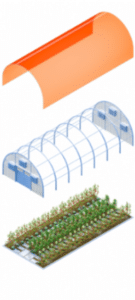
UbiGro appears orange to the human eye because it is glowing with a peak color of 600 nm. This is the most efficient color within PAR for photosynthesis and is the foundation of all UbiGro products. UbiGro Cover, a leading greenhouse covering material, is more than just a protection for your crop; it is actually a layer of light powered by the sun that is glowing over your crop. The glow comes from capturing UV and some blue photons and converting these to efficient red light that powers photosynthesis. For more information on Plant Photobiology, greenhouse poly film, and how color affects plant growth check out our technology page.
With a double-wall poly greenhouse, should UbiGro cover be the inside layer, outside layer or both?

While using UbiGro Cover as both layers of a double-wall system could possibly be great, we recommend using it as one layer in a double system. UbiGro can be used as either the inner or outer layer and is built to last in both environments. Utilizing the best greenhouse covering material, such as UbiGro, optimizes your greenhouse poly film’s effectiveness.
Deciding whether to use the UbiGro Cover in your greenhouses as an inside or outside layer can depend on many factors like:
- Does the other layer contain UV blocker or IR?
- Location can also be a factor depending on northern or southern locale or even altitude.
If you have questions about your farm and what will be the best solution for you, the UbiGro team can help advise what is best for your greenhouse.
If UbiGro Cover were to rip or fall onto my crop, can the quantum dots in the poly be dangerous to my crop or staff?
Absolutely not! The Quantum Dots used by UbiGro are from UbiQD’s exclusive license to produce safe, non-toxic QDs made with copper, zinc, and sulfur. These QDs are embedded into the polymer where they are protected from the elements and perfectly safe. Check out our Nobel Prize in Chemistry for our quantum dot greenhouse technology.
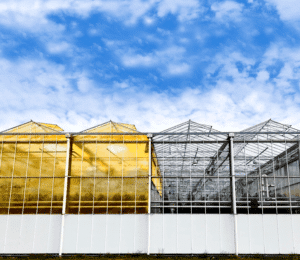 Where is UbiGro Cover sold?
Where is UbiGro Cover sold?
UbiGro has a team of sales people across the US. Click HERE to have a sales representative reach out to you directly. Currently, UbiGro cover, a top greenhouse covering material, is manufactured in the US for sales across all of North America and can be shipped overseas for any potential international partners. UbiGro is working to partner with international greenhouse poly film and best greenhouse covering manufacturers to make UbiGro Cover and film available around the world.
Looking to learn more about other sustainable greenhouse practices and greenhouse covers? Talk to one of our greenhouse experts today!

Dr. Damon Hebert
Dr. Damon Hebert serves as Director of Agriculture Research for UbiQD, Inc., with a background in solar materials and controlled environment cannabis cultivation. He is an advocate for the use of advanced materials to further the industry’s push towards sustainable farming practices. He can be reached at [email protected].
Share:
Connect With Us
Company
Resources
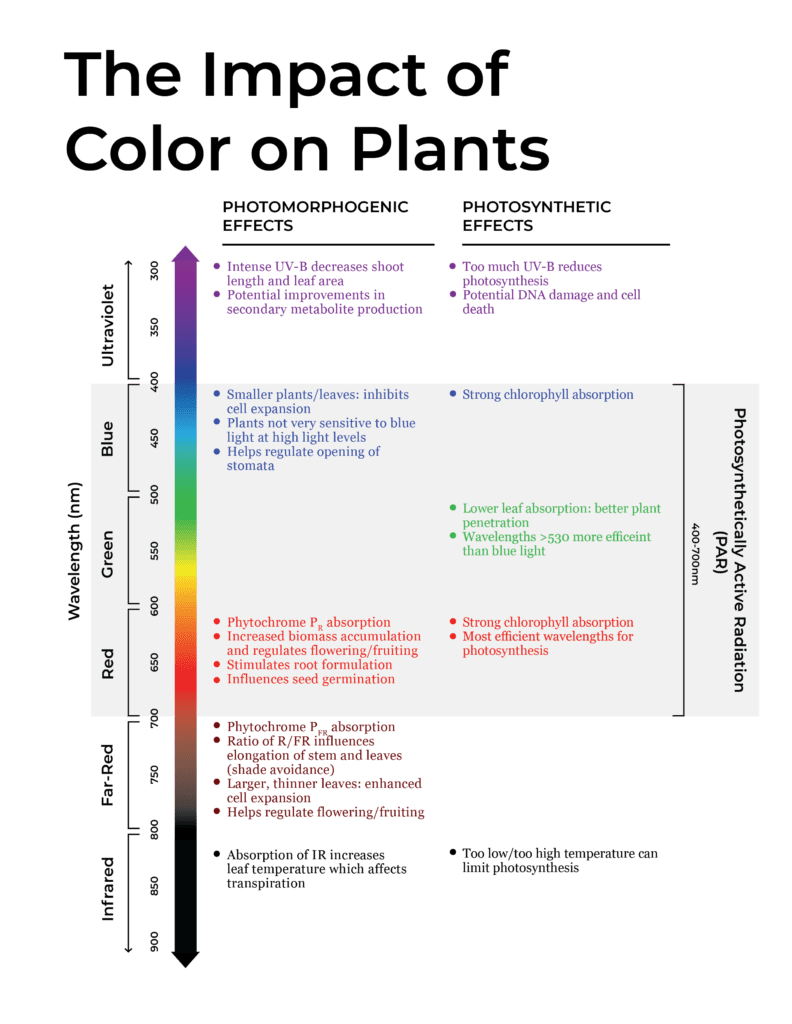

Hunter McDaniel, PhD
Founder & CEO
Hunter earned a Ph.D. in Materials Science and Engineering at the University of Illinois at Urbana-Champaign, before joining Los Alamos National Laboratory in the Chemistry Division. Ultimately the value proposition of UbiGro is about boosting crop yields and quality without the cost or energy impact of lighting. Hunter has more than fifty publications and patents, and more than 2000 total citations, h-index: 20. Hunter fundamentally believes that novel materials underpin every significant technology advancement, and he is focused on leveraging new materials to have a lasting and sustainable impact.

Damon Hebert, PhD
Director of Agriculture
Damon brings a wide range of experience in agriculture, materials science, spectroscopy, and small business. During his time in Prof. Angus Rockett’s research group at The University of Illinois at Urbana-Champaign (UIUC), Hebert authored a doctoral thesis and multiple papers on the materials science of CIGS semiconductor materials, which is closely related to the materials developed at UbiQD. He also served as a consultant to Nanosolar, a CIGS nanocrystal solar cell manufacturing company. Hebert has industry experience having co-founded Dr. Jolly’s, a leading cultivation and distribution operation in Bend, OR.

Tania Lafaille
Sales Representative
Tania is a UbiGro Sales Representative, with over 7 years of experience in product sales (specifically berries and avocados) covering all of North America and parts of South America. While in agriculture, Tania has cultivated strong relationships with growers and distributors, granting her a unique insight into both perspectives. That understanding, paired with her fierce dedication to results, drives her fun and fiery commitment to her craft. Tania is based in Gilroy, CA.

Tyler Veyna
Sales Representative
Tyler brings 15 years of experience in Greenhouse production and facility management of a wide range of crops in multiple states to the UbiGro team. Based in Salinas, California. “Being a fourth-generation farmer, I look to improve and empower the grower, and with UbiGro, we can do just that.”

Jim Gideon
Sales Manager
Jim Gideon is an UbiGro Sales Manager, with over 25 years of greenhouse industry sales experience covering all of North America. Previously Jim has worked for Green Tek, Plazit-Polygal, Texel, Cherry Creek, and Nexus. He is based in Montgomery, AL, and Jim believes that “light is everything to the grower.”

Eric Moody
Director of Sales
Eric Moody is UbiQD’s Director of UbiGro Sales. Eric has more than 6 years of experience in horticulture lighting industry, building relationships with greenhouse growers of all sizes and crops on optimal lighting for their growing operation, and most recently managed a North American sales team for PL Light Systems. Overall, Eric has been in sales leadership positions for more than 13 years. Eric brings with him a great understanding of the market and available technologies for growers, greenhouse facilities, and sales leadership. Reach Eric by phone at 541-490-6421 or by email at [email protected].

Mike Burrows, PhD
Dr. Michael Burrows is UbiQd’s Vice President of Business Development. His educational background includes a Materials Science doctorate from the University of Delaware and an MBA from Duke University Fuqua School of Business. His career has specialized in the commercialization of novel electronic materials in venture-run programs for different industries including solar, biosensors, and the automotive industry. In both start-up and corporate environments, he has extensive experience in global market development, foraging supply chain partnerships, productization, and brand building. He is currently leading UbiQD’s partnership efforts in luminescent greenhouse technology, smart windows, and security ventures.

Matt Bergern, PhD
Cheif Product Officer
As Chief Product Officer at UbiQD, Dr. Matt Bergren leads the company’s product development efforts, sales, and product manufacturing, including the company’s first commercial agriculture product, UbiGro. He plays a critical role in continuing the company’s path of technology development and vision of powering product innovations in agriculture, clean energy, and security.
He serves as the principal investigator for UbiQD’s contract with NASA, focused on tailoring the solar spectrum for enhanced crop production for space missions. Dr. Bergren’s leadership experience includes serving on the board of directors for the New Mexico Energy Manufacturing Institute, focused on job creation in New Mexico’s energy, and related manufacturing community.

